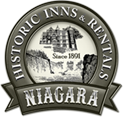Fast Facts
Where to call
| Emergency: |
911 |
| Ambulance: | (905) 688-2191 |
| Police Department (Non-Emergency): | (905) 688-4111 |
| Fire Department: | (905) 356-1321 |
| CAA Emergency Road Service: | (905) 684-4396 |
| Weather: | (905) 688-1847 |
| Hospitals - Greater Niagara General Hospital: | (905) 358-0171 |
Police
In case of an emergency, dial 911. This emergency number is available for the entire Niagara Region.
Weather & Road Reports
| Weather: | 905 227-3393 |
| Roads: | 905 682-6641 |
| Ontario: | 1-800-268-1376 |
Newspapers
Niagara Falls has one daily newspaper, the Niagara Falls Review.
Radio and T.V.
CJRN (710 AM) is an all-news radio station. Buffalo radio Station WBFO (88.7 FM) is a member of National Public Radio. CFLZ (91.9 FM) is operated by the Niagara Parks Commission and provides information about events, attractions and bridges.
The major TV channels are 2 (NBC), 4 (CBS), 7 (ABC) out of Buffalo, 5 (CBC) and 9 (CTV) out of Toronto and 11 (CHCH) out of Hamilton.
What to wear
The coldest months in Niagara Falls are November through March, when temperatures average between -6 and 4°C (21 and 39°F).
Snowfall is abundant during the winter months. April and October are also brisk.
June, July and August are balmier, with average highs of 25°C (77°F) and lows of 15°C (59°F).
Keep in mind that the falls affects local weather conditions. Even on the sunniest days, visitors close to the falls can get quite wet from the mist if the wind is blowing their way. Be prepared to wear rain gear or to don dry clothing.
The Falls
- The Canadian Horseshoe Falls plunges 52 metres (170 feet) into the Maid of the Mist Pool.
- At the American Falls the water's vertical descent ranges from 21 to 34 metres (70 to 110 feet) to the rock at the base of the Falls.
- The Niagara Gorge extends from the Falls for 11 kilometres (7 miles) downstream to the foot of the escarpment at Queenston.
- More than 168,000 cubic metres (6 million cubic feet) of water go over the crestline every minute during peak daytime tourist hours.



